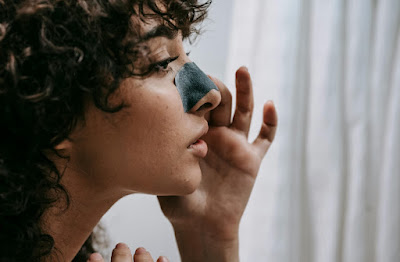The "blackheads" on your nose may not actually be "blackheads."
First, let's address a common misconception: many people equate the concept of "blackheads" with "blackhead acne." However, there's actually a distinction between the two.
Blackhead acne is a manifestation of acne (or what we commonly refer to as "pimples"). Its contents typically consist of a large number of keratinocytes, microorganisms, and amorphous substances. If not addressed promptly, it may progress further into inflammatory acne.
In comparison, the contents of blackheads contain relatively fewer cells and microorganisms. They generally fall into two categories: one where sebum and keratinocytes accumulate together in the pores, and the other where there's a significant presence of hair-like structures containing melanin, making them appear very dark. Here, we'll mainly discuss the causes, classification, and treatment methods of blackheads.
Causes of blackheads:
1. Excessive sebum secretion: Blackheads tend to occur more frequently in the T-zone, where sebaceous glands are abundant. They are also more noticeable and prevalent in summer than in winter.
2. Excessive cell proliferation: Many cells blocking the pores can be found in blackheads, but compared to blackhead acne, the number of cells is relatively fewer, and the connections between cells are not as tight as in acne.
Classification of blackheads:
Based on the composition of the plug in the hair follicle, blackheads can be roughly divided into four types: sebum plug type, sebaceous filament type, keratin plug type, and hair-like plug type.
Treatment methods for blackheads:
For different types of blackheads, different treatment methods are usually required. Commonly used methods include:
1. Chemical exfoliation: Commonly used acids such as glycolic acid, salicylic acid, or compound acids can dissolve lipids by lowering the pH value, thus breaking down the connection between keratinocytes and achieving the goal of removing blackheads. This method is effective for sebum plug type and keratin plug type blackheads.
2. Comedone extraction: This method employs purely physical means to remove blackheads by squeezing them out. It's suitable for stubborn blackheads with a small number of lesions. However, before using comedone extraction, it's important to thoroughly moisten the face to hydrate the pores and the sebum plugs within them. Therefore, it can be done after applying a mask or in conjunction with chemical exfoliation.
3. Other methods: For hair-like plug type blackheads, we can also use peel-off masks combined with fine tweezers for removal. The effect is also very good, but attention should be paid to aseptic operation and frequency of use to avoid damaging the skin barrier.
In summary:
When dealing with blackhead issues, it's essential to first identify which type of blackhead is troubling us, and then take appropriate measures to effectively remove them. If you're unsure about the type of blackhead you have or which method is best for you, you can also seek help from a professional dermatologist at a hospital. The above information covers relevant knowledge about blackheads, and if you have any questions or suggestions, feel free to leave a message to share with us.
#skincare #beauty tips #eye mask #eye patch #eye cream #viicode eye mask#viicode eye patch#anti aging #ESS #eastsuperstar
VIIcode blog: https://viiblog.com/index.php?route=blog/category&blog_category_id=3
VIIgarden: https://us.viigarden.com/




Comments
Post a Comment